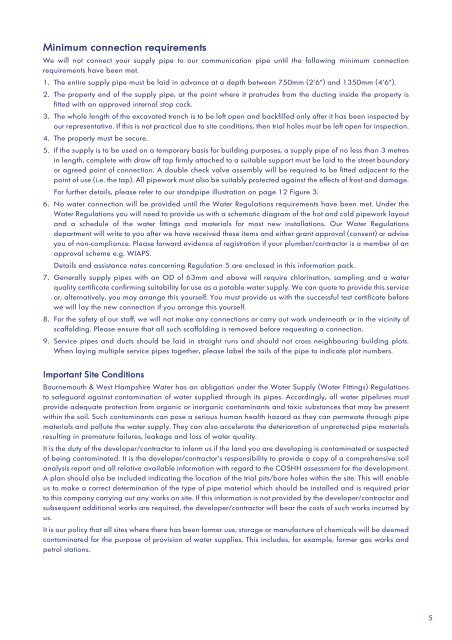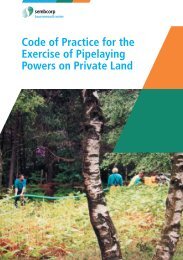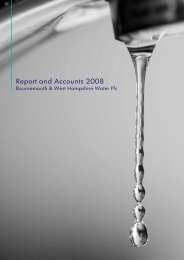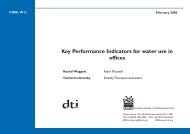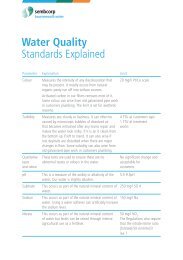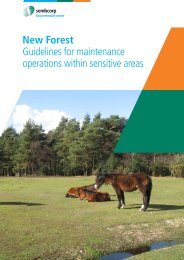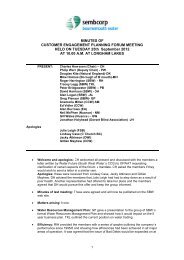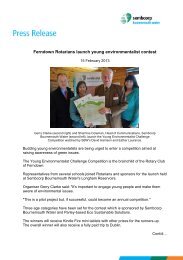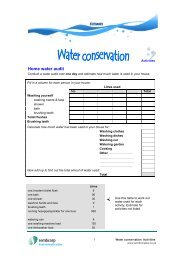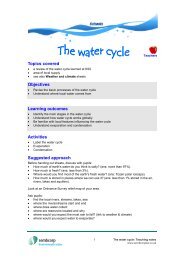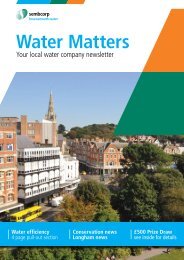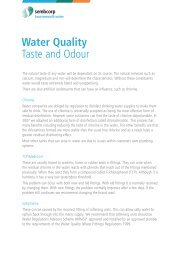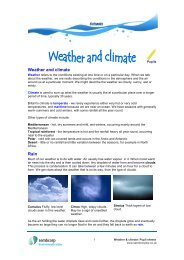You 1 - Sembcorp Bournemouth Water
You 1 - Sembcorp Bournemouth Water
You 1 - Sembcorp Bournemouth Water
You also want an ePaper? Increase the reach of your titles
YUMPU automatically turns print PDFs into web optimized ePapers that Google loves.
Minimum connection requirements<br />
We will not connect your supply pipe to our communication pipe until the following minimum connection<br />
requirements have been met.<br />
1. The entire supply pipe must be laid in advance at a depth between 750mm (2’6”) and 1350mm (4’6”).<br />
2. The property end of the supply pipe, at the point where it protrudes from the ducting inside the property is<br />
fitted with an approved internal stop cock.<br />
3. The whole length of the excavated trench is to be left open and backfilled only after it has been inspected by<br />
our representative. If this is not practical due to site conditions, then trial holes must be left open for inspection.<br />
4. The property must be secure.<br />
5. If the supply is to be used on a temporary basis for building purposes, a supply pipe of no less than 3 metres<br />
in length, complete with draw off tap firmly attached to a suitable support must be laid to the street boundary<br />
or agreed point of connection. A double check valve assembly will be required to be fitted adjacent to the<br />
point of use (i.e. the tap). All pipework must also be suitably protected against the effects of frost and damage.<br />
For further details, please refer to our standpipe illustration on page 12 Figure 3.<br />
6. No water connection will be provided until the <strong>Water</strong> Regulations requirements have been met. Under the<br />
<strong>Water</strong> Regulations you will need to provide us with a schematic diagram of the hot and cold pipework layout<br />
and a schedule of the water fittings and materials for most new installations. Our <strong>Water</strong> Regulations<br />
department will write to you after we have received these items and either grant approval (consent) or advise<br />
you of non-compliance. Please forward evidence of registration if your plumber/contractor is a member of an<br />
approval scheme e.g. WIAPS.<br />
Details and assistance notes concerning Regulation 5 are enclosed in this information pack.<br />
7. Generally supply pipes with an OD of 63mm and above will require chlorination, sampling and a water<br />
quality certificate confirming suitability for use as a potable water supply. We can quote to provide this service<br />
or, alternatively, you may arrange this yourself. <strong>You</strong> must provide us with the successful test certificate before<br />
we will lay the new connection if you arrange this yourself.<br />
8. For the safety of our staff, we will not make any connections or carry out work underneath or in the vicinity of<br />
scaffolding. Please ensure that all such scaffolding is removed before requesting a connection.<br />
9. Service pipes and ducts should be laid in straight runs and should not cross neighbouring building plots.<br />
When laying multiple service pipes together, please label the tails of the pipe to indicate plot numbers.<br />
Important Site Conditions<br />
<strong>Bournemouth</strong> & West Hampshire <strong>Water</strong> has an obligation under the <strong>Water</strong> Supply (<strong>Water</strong> Fittings) Regulations<br />
to safeguard against contamination of water supplied through its pipes. Accordingly, all water pipelines must<br />
provide adequate protection from organic or inorganic contaminants and toxic substances that may be present<br />
within the soil. Such contaminants can pose a serious human health hazard as they can permeate through pipe<br />
materials and pollute the water supply. They can also accelerate the deterioration of unprotected pipe materials<br />
resulting in premature failures, leakage and loss of water quality.<br />
It is the duty of the developer/contractor to inform us if the land you are developing is contaminated or suspected<br />
of being contaminated. It is the developer/contractor’s responsibility to provide a copy of a comprehensive soil<br />
analysis report and all relative available information with regard to the COSHH assessment for the development.<br />
A plan should also be included indicating the location of the trial pits/bore holes within the site. This will enable<br />
us to make a correct determination of the type of pipe material which should be installed and is required prior<br />
to this company carrying out any works on site. If this information is not provided by the developer/contractor and<br />
subsequent additional works are required, the developer/contractor will bear the costs of such works incurred by<br />
us.<br />
It is our policy that all sites where there has been former use, storage or manufacture of chemicals will be deemed<br />
contaminated for the purpose of provision of water supplies. This includes, for example, former gas works and<br />
petrol stations.<br />
5


